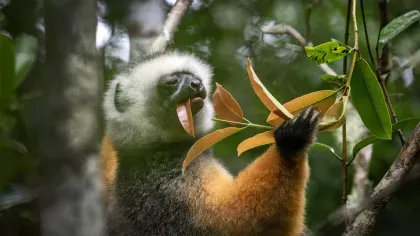5 March 2023
Margaret Mee - in pursuit of the moonflower cactus
Margaret Mee paintings of the rare moonflower cactus document her intrepid exploration for this elusive flower across the Amazon.

From the first time Margaret Mee saw the moonflower cactus Strophocactus wittii, on her third expedition to the Amazon in 1964, she was determined to paint its flower, which blooms only one night a year. As the name might suggest, the moonflower only flowers at night.
However, Margaret Mee’s first sightings were made in daylight, at times catching the cactus just after its creamy white flowers had closed. Very little was recorded about this epiphyte (a plant that grows on other plants using clinging roots) at the time, meaning Mee’s field notes and studies were not only stunning works of art but important documents for furthering scientific knowledge.
In 1972, Mee chose to travel the River Daraá in the hope that she would see the moonflower cactus that she had first glimpsed back in 1964. She wrote in her diary:
“…we had not gone far into the river when we found a beautiful igapó [a type of flooded forest] and within moments I saw the cactus… It was growing flat as a scarlet transfer against the trunk, for the roots which grow on the back of the leaf secure it to the bark.”

Mee’s 1978 study of Strophocactus wittii captures how the leaves cling to the trunk in bold crimson, yellow and green.
The striking composition in this 1978 painting places the cactus within context, showing how it relies upon other plants to grow and representing the rainforest ecosystem as a whole. This contrasts to Mee’s more traditional botanical illustration, which places a specimen in isolation on a white background.
Through these paintings, Mee drew attention to the Amazon’s incredible variety and abundance of plant life which depends upon its environment to thrive. These unique and rich environments of the Amazon had begun to rapidly disappear since the 1960s. She defended the Amazon in both word and image, sketching the devastation of the landscape and speaking out against deforestation.

In 1988, Mee realised her ambition to find and paint the open moonflower within its natural environment. She described the experience of watching the pale cream petals unfurl from their crimson flecked stems by torchlight in her diary:
“In the early stages an extraordinarily sweet perfume wafted from the flower, and we were all transfixed by the beauty of the delicate and unexpectedly large bloom, fully open in an hour. Open at last it was a curious flower and totally different to any I had painted before. Also it was a challenge as I was balanced precariously on the six foot wide top of the boat… luckily the night was still and without a breath of wind, so I could work easily.”
The flowering moonflower paintings were to be Margaret Mee’s last. Just as the moonflower bloom is both rare and too short, so too was her life. Just over six months after she captured the beauty of the moonflower cactus in bloom she died in a car crash back in England.
Her works and legacy live on inspiring both contemporary botanical artists, along with all of us to care and stand up for the incredible plant life of our planet.


